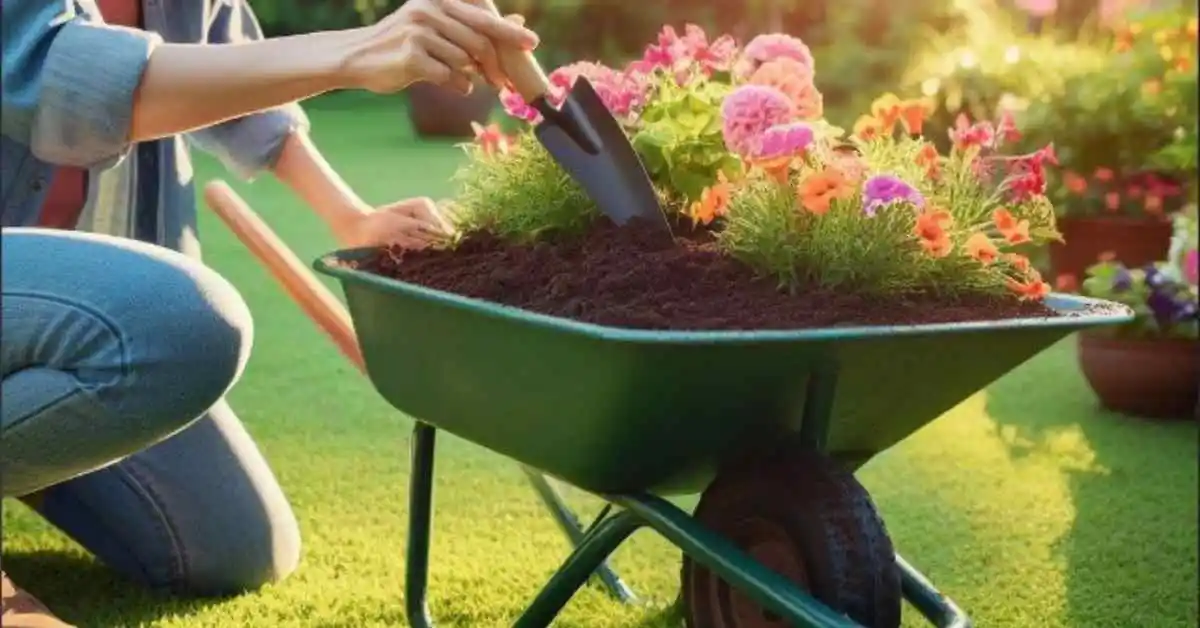Gardening enthusiasts often seek creative ways, like how to plant flowers in a wheelbarrow, to showcase their floral masterpieces.
One unique and charming option is transforming a humble wheelbarrow into a mobile garden, adding a touch of whimsy and practicality to your outdoor space.
In this personalized guide, we will explore the steps to create your own blooming wheelbarrow oasis, offering insights into the art of planting flowers in this unconventional yet delightful container.
Choosing the Right Wheelbarrow:
Selecting the right wheelbarrow is crucial before you dive into the world of wheelbarrow gardening. Opt for a sturdy, well-constructed wheelbarrow with a deep basin, providing ample soil and plant root space.
Consider the aesthetic appeal of the wheelbarrow as well, as it will serve as the canvas for your floral masterpiece.
You can also follow these to prepare your old wheelbarrow for planting flowers.
Steps to plant flowers in a wheelbarrow
Step 1: Prepare the Wheelbarrow:
Start by cleaning the wheelbarrow thoroughly to remove any dirt or debris. This enhances the visual appeal and ensures a healthier environment for your plants. If the wheelbarrow has been sitting outside, check for rust in your wheelbarrow and apply a coat of rust-resistant paint to protect it from the elements.
Step 2: Add a Layer of Drainage Material:
To ensure proper drainage and prevent waterlogged soil, place a layer of pebbles or broken terracotta pots at the bottom of the wheelbarrow. This layer will allow excess water to escape, preventing root rot and other water-related issues.
Step 3: Choose the Right Soil:
Select a high-quality potting mix suitable for the types of flowers you intend to plant. Ensure the soil is well-draining and nutrient-rich to promote healthy plant growth. Fill the wheelbarrow with the soil, leaving enough space for the plants to settle comfortably.
Step 4: Select Your Flowers:
Choosing the right flowers is critical to creating a visually stunning wheelbarrow garden. Consider the sunlight conditions in your garden and select flowers that thrive in those conditions. Mix and match colors, sizes, and textures to create a vibrant and dynamic display.
Step 5: Planting the Flowers:
Dig holes in the soil of the wheelbarrow according to the spacing requirements of each type of flower. Carefully remove the plants from their containers and place them in the prepared holes. Gently pat the soil around the base of each plant to secure them in place.
Step 6: Watering and Mulching:
After planting, water the flowers thoroughly to help them settle into their new home. Apply a layer of mulch on top of the soil to retain moisture, suppress weeds, and enhance the overall aesthetic appeal of the wheelbarrow garden.
Step 7: Placement and Maintenance:
Considering the sunlight and visual impact, find the perfect spot for your wheelbarrow garden. Wheel it around your garden as needed, adding a dynamic element to your outdoor space. Regularly water and fertilize the plants as required, and keep an eye out for any signs of pests or diseases.
Best Plants for Your Wheelbarrow Garden:
Here are certain flower plants ideal for your wheelbarrow-
- Petunias (Petunia spp.): Known for their vibrant colors and cascading growth habits, petunias are an excellent choice for wheelbarrow planters. They come in various shades, making it easy to create a visually appealing display.
- Geraniums (Pelargonium spp.): Geraniums add a classic touch to any garden with their eye-catching blooms and lush foliage. They are relatively low-maintenance and can withstand different weather conditions.
- Marigolds (Tagetes spp.): Marigolds bring a splash of warm, golden hues to your wheelbarrow garden. These hardy flowers are known for their pest-repelling properties, making them a practical and beautiful choice.
- Diascias (Diascia spp.): These delicate, trailing flowers produce clusters of blooms that spill over the edges of the wheelbarrow, creating a soft and graceful look. They thrive in well-drained soil and partial sunlight.
- Lobelia (Lobelia spp.): Ideal for adding a touch of blue or purple to your garden, lobelia is a compact and versatile plant. It’s well-suited for the edges of the wheelbarrow, providing a lovely border.
Conclusion:
Transforming a wheelbarrow into a blooming garden is a delightful and rewarding endeavour. How to plant flowers in a wheelbarrow becomes a seamless and joyful process when you follow these steps.
By incorporating the chosen flowers into your wheelbarrow and strategically arranging them, you can create a personalized and charming floral display that touches nature’s beauty in any corner of your outdoor space.
Embrace your creativity, experiment with different flower combinations, and watch as your wheelbarrow garden becomes a focal point of admiration in your home. Happy gardening!

